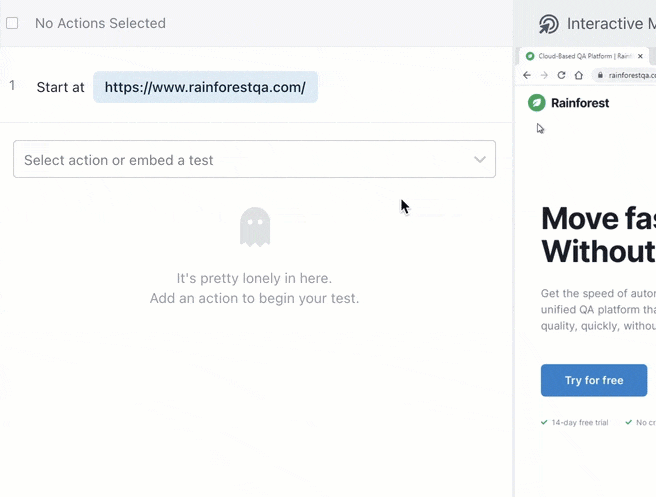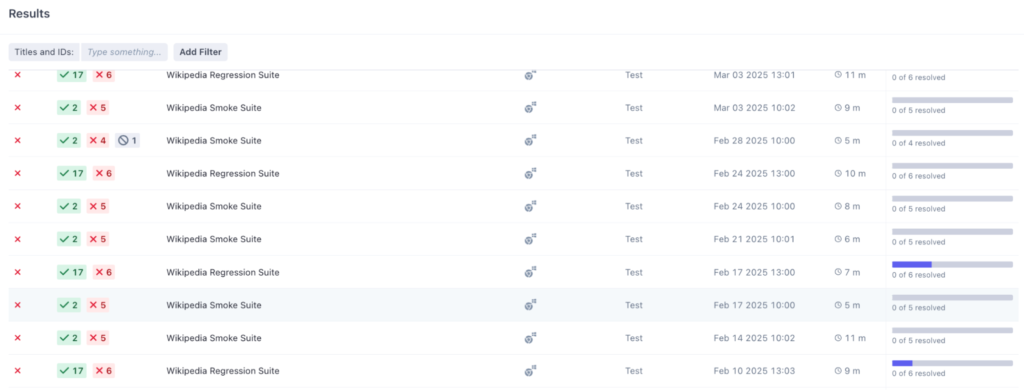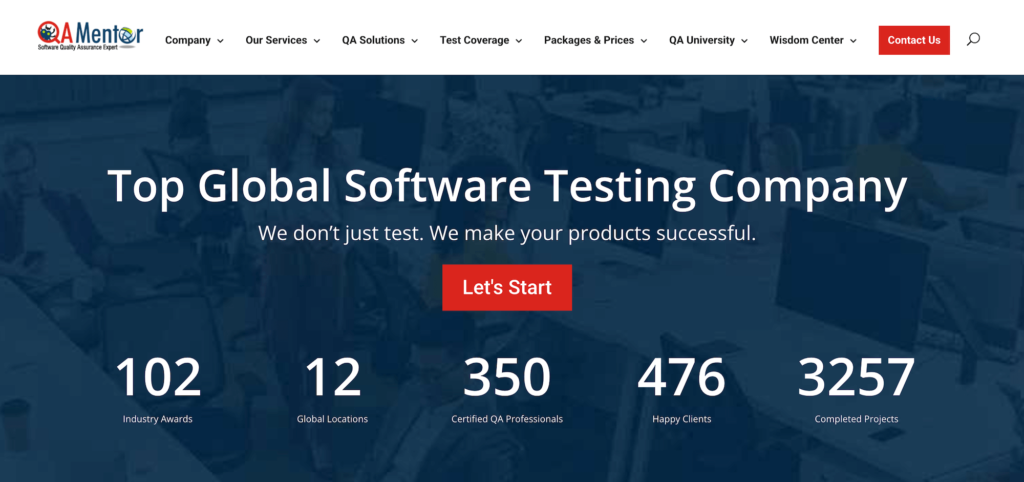Outsourcing quality assurance (QA) to a high-quality software testing service can be a good way to perform more testing at a low cost while freeing developers from test creation and maintenance.
However, through surveys and interviews with numerous engineering leaders, we found that not all software testing services can deliver on these benefits. Many are notoriously slow and struggle to catch obvious bugs in critical user paths.
To help you distinguish high-quality testing services from those that might slow you down, we’ve compiled a list of key questions to guide your evaluation:
Can they automate test maintenance? Many services write brittle tests in outdated frameworks like Selenium that break after your team pushes any change. You have to wait for the service to manually update tests to represent the new version of your application before shipping again. Partner with a service that automates this process.
Can they test the UI directly? Many services test code elements in your application that represent UI elements. They don’t test the UI itself. As a result, they miss obvious UI bugs not present in the code (we explain how this happens below). Pick a service that creates automated tests to directly validate the UI.
Can they test user paths that happen outside the browser? Another limitation of outdated testing solutions like Selenium is that they can only test user paths inside a single browser window. This is a common reason why bugs outside the browser slip into production. Opt for a service that can test inside and outside the browser.
How well can they integrate into your workflows? Many services don’t integrate fully into your workflows, and therefore never learn about your application like an in-house hire. This forces you to closely manage them. Choose a testing service that can integrate into your workflows and let you step away from QA completely.
Can you view tests, test cases, steps, results, and other details? Many testing services don’t give you insight into what they’re testing and the outcomes of those tests. Software development teams don’t know what’s actually being tested. Choose a service that offers 100% transparency into their tests.
This guide outlines five software testing services on the market and compares their testing process and methodologies to the questions above.
We start by discussing our software testing service, Rainforest QA, and how we designed them around the five factors mentioned above.
Book a quick call to learn more about how Rainforest QA can take software testing off your plate — for less than half the cost of a full-time engineer.
1. Rainforest QA
A software testing service designed around shipping speed and reliability

Rainforest QA is a software testing service based in the U.S. We use our own no-code platform to write automated tests and run them on full virtual machines or VMs. This allows us to test an application’s UI directly while relying on the underlying code.
In addition, we use a patent-pending AI to automate test maintenance. It reviews all failed test steps and, if it sees that a change was intentional and not caused by a bug, automatically updates the corresponding test script without our test managers having to step in manually.
Rainforest assigns two dedicated test managers to your account who will:
- Operate like an in-house hire by joining Slack, Jira, and other tools. They attend standups and learn your application, its nuances, and your team’s priorities.
- Create and maintain all automated tests.
- Run tests in parallel on our VMs, enabling you to get results for entire test suites in just four minutes.
- Kick off tests within your DevOps pipeline.
- Identify and filter out false positives.
- Verify all automated AI updates to test scripts.
- Send video recordings and key bug details to developers via Jira, so they can find and fix issues faster.
Rainforest’s AI automates test maintenance so you can ship faster
Engineering leaders’ number one problem with testing services, as they mentioned in interviews and surveys, is that tests break with intentional updates deployed by their team. Any change triggers a host of false positives, and teams have to wait hours or even days for testing services to manually update broken tests.
Engineering leaders had to halt all updates during this time or release them regardless, ignore failing tests, and hope that no bugs make it into production.
This problem is caused by testing services writing brittle tests inside legacy tools like Selenium.
These tests require an exact match to either a code or a visual element to know what to test. If your team pushes an update and these elements change, even slightly — maybe a button moves 10 pixels or a locator ID in the code changes from “submit-button” to “sbm-button” — the test breaks. It’s looking for elements that no longer exist or have been moved.
Rainforest uses patent-pending AI, trained on over a decade of testing data across thousands of tests, to automate test maintenance. Our AI emulates a user’s judgment and can tell whether a change was intentional or a bug.
If the change was intentional, it automatically updates the associated test script without test managers having to fix them manually. All AI-driven changes are reviewed by Rainforest test managers for accuracy.
For example, say a test failed because a dropdown menu changed to a set of radio buttons, or a developer rearranged the order of fields in a checkout form. The Rainforest AI will understand it’s not a bug and automatically change the test script to reflect the change.
However, if a pop-up overlaps with the checkout button or a login form accepts invalid credentials without showing an error message, the AI will know it’s a bug. It keeps the test script the same and notifies developers of the issue with a video replay of the bug.

Read more: Top 5 regression testing services & key factors to consider
Rainforest’s AI lets test managers create tests faster than coding them from scratch
Another reason why engineering leaders often have to wait hours or days before shipping updates is that software testing services take too long to create tests.
Testing services write tests in code, so they must manually specify every detail, like an element’s exact text, color, position on screen, and the sequence of user interactions. This slows down each release.
With Rainforest, test managers write automated test steps in plain English and our AI converts it into test scripts. Zero coding is required. As a result, creating tests in Rainforest is three times faster than coding them from scratch inside tools like Playwright:
To further speed up test creation, Rainforest’s no-code platform includes a feature called embedded tests, which allows our test managers to create a test for a user path and embed it across any other workflow. Then, when they need to update that workflow, they only do it once — it automatically updates across all tests, speeding up test maintenance.

Rainforest automated tests interact with your application’s visual layer directly
A functional testing service’s reliability in detecting bugs before they reach production is a critical factor to consider when deciding which service to outsource to.
Many software testing services can’t reliably detect bugs, even visually obvious ones, because their test scripts interact with the application’s code, not the UI. This creates a blind spot where UI bugs can slip through undetected by code-based tests.
For example, say a checkout form overlaps with a floating footer, hiding the “Buy” button from users. A test that interacts with the code will see the locator ID for the buy button in the code and believe it’s in the UI for users to click on.
We used a simple example to keep this section brief. However, there are countless ways test scripts that test code elements miss UI bugs that don’t show up in the code.
It is possible to catch many of these visual bugs by coding provisions into the test, such as the exact pixel location that the button must be in. However, most services don’t do this because it’s time-consuming and adds to test brittleness.
Rainforest automated tests interact with your application’s visual layer directly, like a manual tester would. We can do this because our tests run on full, cloud-based VMs, which simulate users opening up and clicking on buttons, forms, and icons in your application.

Rainforest uses optical character recognition to match UI elements to screenshots captured when test managers created tests. This is a more reliable way to identify visual regressions than testing code elements, which may not accurately represent the UI.
If a buy button is hidden by a floating footer, like in the example above, our optical character recognition technology won’t be able to match the screenshot with anything on screen and will fail the test.
Read more: Top 5 web application testing services & how to choose
Rainforest runs tests on entire VMs, so we can test user flows outside the browser
When outsourcing QA to a software testing service, engineering leaders want confidence that all critical user flows, not just those that happen entirely within one browser, are being tested.
Unfortunately, many software testing services run tests in headless browsers and thus, can only test actions within the browser.
For example, they may be able to test that a download starts, but won’t be able to open the file and validate that the content is correct. Ultimately, this causes bugs outside the browser to go live.
To have confidence in your application, a testing service should be able to test actions outside the browser.
Rainforest QA doesn’t run automated tests in headless browsers like most testing services. We run tests in VMs that emulate real Mac, Windows, iOS, and Android devices. This means that we can test any action visible on screen. For example, you can test:
- Browser extensions
- Native desktop applications and their UI responses
- File downloads and how they open in associated apps
- Drag-and-drop interactions across windows or apps
- Email notifications as they appear in Gmail
- Content inside PDFs, spreadsheets, and documents after export

Test managers integrate with your team and workflows like an internal hire
The ability for outsourced test personnel to integrate into your workflows and learn about your application is essential to successfully freeing developers from QA. It means your developers don’t have to closely manage the QA process and correct outsourced personnel’s work.
However, many software testing services don’t do a good job of integrating into teams’ workflows. This prevents you from confidently stepping back, knowing the testing team may not have a clear understanding of your application.
There are various reasons for this, mainly because testing services frequently rotate personnel, causing a loss of knowledge and requiring engineering leaders and developers to remain closely involved in QA.
Other reasons include test personnel working outside your time zone and thus being unable to join important meetings.
At Rainforest, we designed our service to mirror internal hires as much as possible. Our QA team integrates into your workflows and tools (e.g., Slack, Jira, Trello) and can join standup meetings because they work in your time zone.
We never rotate test managers; they stay on your account long term, and this continuity enables them to learn about your application’s intricacies.
You may need to guide test managers in the early stages of the engagement, but after a month or two, they will have all the knowledge needed to take test writing and maintenance completely off your plate.
You have full control over what is tested and can view all tests and test details
Most quality assurance services don’t give you visibility into their tests. They replicate your application environment on their end and write test scripts using their own tools. You can’t see what they’re testing and how well your application is performing.
Testing companies may tell you they have covered 70% of your application, for example, but you can’t see which workflows are being tested. This makes it difficult to have confidence knowing that your critical user paths are bug-free.
At Rainforest, we don’t build tests in a black box. We write tests inside our no-code platform, which you or anyone on your team can access. You can see all the tests your test managers created, know exactly which parts of your application are getting coverage, and draw conclusions on software quality and user experience.

We’ll work alongside you during onboarding to develop an automated testing strategy that aligns with your most important user paths and test those first. However, if you need a new workflow or feature tested or want to shift priorities, you can message your test manager on Slack. You have full control over what is tested.
Rainforest also offers manual testing services
Automated testing isn’t a practical option for all applications. For example, if a mobile application is still in the early stages of development and elements are constantly changing, automated tests couldn’t keep up and would break frequently.
Consequently, we advise you to choose a software testing service that includes automated and manual testing so you can manage software quality assurance from one platform.
Rainforest offers a community of experienced manual testers. All you have to do is send test instructions to your test manager via Slack and they’ll send it to our tester community.

Our manual testers can return results for entire test suites in 17 minutes, the fastest of any manual testing service provider. Our manual testers even work on weekends, holidays, and are available after hours.
QA testing services for less than half the price of a full-time QA engineer
Schedule a quick demo with our team to see how Rainforest can take software QA off your developers’ plate and ship new code quickly.
2. Qualitest

Qualitest is an end-to-end software testing service based in the U.S. and Canada that caters to a wide range of industries, from financial services and healthcare to e-commerce and artificial intelligence. As one of the world’s leading quality engineering firms, Qualitest distinguishes itself with a strong focus on AI-powered testing, automation, and risk-based strategies.
Clients benefit from a flexible delivery model — onshore, offshore, and hybrid — which allows for tailored solutions around business goals. Whether it’s functional testing, performance testing, scalability testing, acceptance testing, API testing, security testing, and more. Qualitest brings deep technical expertise and a commitment to quality. Their use of specialized testing tools and frameworks, combined with domain-specific knowledge, ensures faster release cycles.
What sets Qualitest apart is its proactive approach. Instead of just identifying bugs, they help prevent them early in the development process. This saves time and resources while boosting software reliability.
That said, it’s worth pointing out that Qualitest does use open-source frameworks such as Selenium to write tests. These frameworks are notorious for being brittle and breaking after almost any change, even small ones. As a result, we’re unsure how Qualitest speeds up releases.
3. Testlio

Testlio is an ISO-compliant software testing company that offers both functional and non-functional services. It has a global network of highly vetted testers and a platform supporting managed and on-demand testing. Testlio markets itself as a QA automation company emphasizing speed, flexibility, and real-world testing conditions.
Their crowd testing model is particularly powerful. It connects clients with skilled testers across different devices, geographies, and use cases, resulting in broader test coverage and insights that simulate real customer experiences. Whether it’s regression testing, IoT testing, usability validation, or localization, Testlio optimizes product quality across markets.
What makes Testlio different is its hybrid model: expert QA professionals guide the testing strategy, while the tester community living overseas executes it.
But like most services, including Qualitest, Testlio uses open-source frameworks to write tests. As we discussed above, these frameworks test the underlying code of your application, not the UI, which can lead to less accurate test results than a service like Rainforest, which tests the UI directly.
Read more: The best Testlio alternatives
4. QA Mentor

QA Mentor is a one-stop shop for reliable and cost-effective software testing services. It offers QA services for startups, SMEs, and growing tech teams. With a strong emphasis on manual and automated testing, QA Mentor positions itself as a cutting-edge QA partner capable of adapting to different project needs and development methodologies.
Services include functional testing, regression testing, usability testing, compatibility testing, performance validation, and more, all aimed at ensuring software behaves as expected in real-world scenarios.
Some reviewers say that QA Mentor’s strength lies in its affordability. This makes it especially attractive for smaller companies or early-stage products that require rigorous QA but might not have the resources for an in-house team.
However, QA Mentor uses legacy tools like Selenium as part of its technology stack, so it’s possible that clients may experience slowdowns and bugs when entering production.
5. MuukTest

MuukTest delivers a modern, AI-powered approach to software testing services. Their website claims to combine a proprietary automation platform with expert-led services to help teams achieve up to 95% end-to-end test coverage within just three months.
The platform supports a wide range of testing types — including regression, API, mobile app, and exploratory testing — while integrating seamlessly with CI/CD pipelines. Its no-code and low-code interfaces make test creation accessible, even for teams without deep automation expertise. With features like self-healing tests and smart locators, MuukTest ensures that test maintenance doesn’t become a bottleneck.
A key differentiator is MuukTest’s “done-for-you” model: their QA architects handle test execution, creation, and maintenance, while clients retain full ownership of the test scripts, which are compatible with open-source frameworks like Selenium and Playwright. This flexibility allows teams to scale testing efforts without being locked into proprietary systems.
Ship high-quality code fast with Rainforest QA
Book a call with our team to learn how easy Rainforest QA makes outsourcing your software testing.
